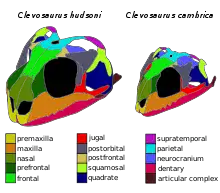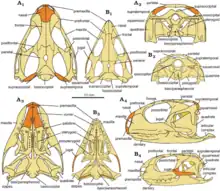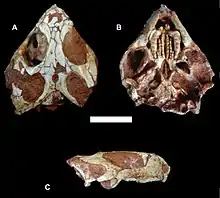| Clevosaurus Temporal range: Late Triassic - Early Jurassic | |
|---|---|
 | |
| Skulls of Clevosaurus hudsoni (left) and C. cambrica (right) | |
| Scientific classification | |
| Domain: | Eukaryota |
| Kingdom: | Animalia |
| Phylum: | Chordata |
| Class: | Reptilia |
| Order: | Rhynchocephalia |
| Family: | †Clevosauridae |
| Genus: | †Clevosaurus Swinton, 1939 |
| Species | |
|
See text | |
| Synonyms | |
| |
Clevosaurus (meaning "Gloucester lizard") is an extinct genus of rhynchocephalian reptile from the Late Triassic and the Early Jurassic periods. Species of Clevosaurus were widespread across Pangaea, and have been found on all continents except Australia and Antarctica.[1] Five species of Clevosaurus have been found in ancient fissure fill deposits in south-west England and Wales, alongside other sphenodontians, early mammals and dinosaurs. In regards to its Pangaean distribution, C. hadroprodon is the oldest record of a sphenodontian from Gondwana,[2] though its affinity to Clevosaurus has been questioned.[3]

History of discovery
The first species of Clevosaurus to be described was C. hudsoni, which was described by William Elgin Swinton in 1939 from a fissure fill deposit in Cromhall Quarry (Magnesian Conglomerate Formation) in the county of Gloucestershire, England, with the name of the county lending its name to the genus.[4]
Description

Species of Clevosaurus varied in body size, with Clevosaurus sectumsemper having an estimated total length of 12 centimetres (4.7 in), while C. hudsoni had a total length of around 25 centimetres (9.8 in). The skull length could range from as little as 1.4 centimetres (0.55 in) in C. sectumsemper and up to 4 centimetres (1.6 in) in C. hudsoni.[5] Notable for their greatly reduced number of teeth (3-6 per jaw quadrant), broad skulls and shortened snouts. The teeth of european clevosaurs tended to be mesio-distally elongated, blade-like, and occluded precisely with the opposite pair of teeth, leaving conspicuous diagonal wear facets and acting as a self-sharpening cutting surface.[6] However, the teeth of C. brasiliensis have a very different morphology with no diagonal wear facets, the teeth of the dentary are all conical excluding the posterior-most tooth which can be up to three-times bigger than any of the other teeth, they also have a unique form of implantation, where the base of the teeth sit deeply within the jaw bones, which is not known of in any other rhynchocephalian.[3]
Paleobiology

Species of Clevosaurus were likely insectivorous. Biomechanical modelling suggests that they had high enough tooth pressures and strong enough bite force to crush chitin, indicating that they had the ability to feed on thick-shelled beetles as well as possibly small vertebrates.[6]
List of species
- †Clevosaurus bairdi Sues et al. 1994 McCoy Brook Formation, Canada, Hettangian
- †Clevosaurus brasiliensis Bonaparte and Sues 2006[7] Caturrita Formation, Brazil, Norian
- †Clevosaurus cambrica Keeble et al. 2018[5] Pant-y-ffynnon Quarry fissure fill, Wales, Rhaetian
- †Clevosaurus convallis Saila 2005[8] St. Bride's Island fissure fill, Wales, Hettangian
- †Clevosaurus hadroprodon Hsiou et al. 2019[9] Santa Maria Formation, Brazil, Carnian
- †Clevosaurus hudsoni Swinton 1939 Cromhall Quarry fissure fill, England, Rhaetian
- †Clevosaurus minor Fraser 1988 Cromhall Quarry fissure fill, England, Rhaetian
- †Clevosaurus sectumsemper Klein et al. 2015[10] Woodleaze Quarry fissure fill, England, Rhaetian
- †Clevosaurus nicholasi Bhat et al. 2023[11] Tiki Formation, India, late Carnian-middle Norian
The three species known from the Sinemurian aged Lufeng Formation of China (C. mcgilli, C.wangi and C. petilus) are now considered indeterminate within the genus.[12] Indeterminate remains are also known from the Stormberg Group (either Elliot or Clarens Formation) of South Africa, dating to the Hettangian.[1]
Phylogeny
Below is a cladogram of the relationships within Clevosauridae based on the phylogenetic analysis of Hsiou et al. (2015):[13]
| Clevosauridae |
| ||||||||||||||||||||||||||||||||||||||||||
"Clevosaurus" latidens was recovered outside of Clevosauridae, as the sister taxon of Opisthodontia.[13] It was subsequently assigned to a new genus, Fraserosphenodon, in 2018.[14]
Position of Clevosaurus within Rhynchocephalia, after DeMar et al. 2022.[15]
| ||||||||||||||||||||||||||||||||||||||||||||||||||||||||||||||||||||||||||||||||||||||||||||||||||||||||||||||||||||||||||||||||||||||||||||||||||||||||||||||||||||||||||||||||||||||||||||||||||||||||||||||||||||||||||||||||||||||||||||||||||||
References
- 1 2 Sues, H. D.; Reisz, R. (1995). "First record of the early mesozoic sphenodontian clevosaurus (lepidosauria: rhynchocephalia) from the southern hemisphere". Journal of Paleontology. 69 (1): 123–126. doi:10.1017/s0022336000026974. S2CID 131414921.
- ↑ "A new sphenodontian from Brazil is the oldest record of the group in Gondwana". phys.org. Retrieved 2019-08-15.
- 1 2 Chambi-Trowell, Sofia A. V.; Martinelli, Agustín G.; Whiteside, David I.; Vivar, Paulo R. Romo de; Soares, Marina Bento; Schultz, Cesar L.; Gill, Pamela G.; Benton, Michael J.; Rayfield, Emily J. (2021-06-03). "The diversity of Triassic South American sphenodontians: a new basal form, clevosaurs, and a revision of rhynchocephalian phylogeny". Journal of Systematic Palaeontology. 19 (11): 787–820. doi:10.1080/14772019.2021.1976292. hdl:1983/af14affc-a26e-426b-83ca-e1833e355882. ISSN 1477-2019. S2CID 240487298.
- ↑ W. E. Swinton. (1939). A new Triassic rhynchocephalian from Gloucestershire. Annals and Magazine of Natural History: Zoology, Botany, and Geology 4:591-594
- 1 2 Keeble, Emily; Whiteside, David I.; Benton, Michael J. (April 2018). "The terrestrial fauna of the Late Triassic Pant-y-ffynnon Quarry fissures, South Wales, UK and a new species of Clevosaurus (Lepidosauria: Rhynchocephalia)". Proceedings of the Geologists' Association. 129 (2): 99–119. doi:10.1016/j.pgeola.2017.11.001. hdl:1983/5afdc677-3ea0-4519-813d-6052ef8370ec.
- 1 2 Chambi‐Trowell, Sofia A. V.; Whiteside, David I.; Benton, Michael J.; Rayfield, Emily J. (16 June 2020). Lautenschlager, Stephan (ed.). "Biomechanical properties of the jaws of two species of Clevosaurus and a reanalysis of rhynchocephalian dentary morphospace". Palaeontology. 63 (6): 919–939. doi:10.1111/pala.12493. ISSN 0031-0239. S2CID 220902843.
- ↑ Bonaparte, J. F.; Sues, H. D. (2006). "A new species of clevosaurus (lepidosauria: rhynchocephalia) from the upper Triassic of Rio Grande do Sul, Brazil". Palaeontology. 49 (1): 917–923. doi:10.1111/j.1475-4983.2006.00568.x. S2CID 26483165.
- ↑ Säilä, Laura K. (2005). "A new species of the sphenodontian reptile Clevosaurus from the Lower Jurassic of South Wales". Palaeontology. 48 (4): 817–831. doi:10.1111/j.1475-4983.2005.00486.x.
- ↑ Hsiou, Annie S.; Nydam, Randall L.; Simões, Tiago R.; Pretto, Flávio A.; Onary, Silvio; Martinelli, Agustín G.; Liparini, Alexandre; Martínez, Paulo R. Romo de Vivar; Soares, Marina B.; Schultz, Cesar L.; Caldwell, Michael W. (2019-08-14). "A New Clevosaurid from the Triassic (Carnian) of Brazil and the Rise of Sphenodontians in Gondwana". Scientific Reports. 9 (1). doi:10.1038/s41598-019-48297-9. ISSN 2045-2322. PMC 6694142. PMID 31413294.
- ↑ Klein, Catherine G.; Whiteside, David I.; de Lucas, Victor Selles; Viegas, Pedro A.; Benton, Michael J. (2015). "A distinctive Late Triassic microvertebrate fissure fauna and a new species of Clevosaurus (Lepidosauria: Rhynchocephalia) from Woodleaze Quarry, Gloucestershire, UK". Proceedings of the Geologists' Association. 126 (3): 402–416. doi:10.1016/j.pgeola.2015.05.003.
- ↑ Bhat, Mohd Shafi; Datta, Debajit; Ray, Sanghamitra; Datta, P. M. (2023-01-02). "A new clevosaurid (Lepidosauria: Rhynchocephalia) from the Upper Triassic of IndiaCitation for this article: Bhat, M. S., Datta, D., Ray, S., & Datta, P. M. (2023) A new clevosaurid (Lepidosauria: Rhynchocephalia) from the Upper Triassic of India. Journal of Vertebrate Paleontology . https://doi.org/10.1080/02724634.2023.2232833". Journal of Vertebrate Paleontology. 43 (1). doi:10.1080/02724634.2023.2232833. ISSN 0272-4634.
{{cite journal}}: External link in|title= - ↑ Jones MEH. 2006 The Early Jurassic clevosaurs from China (Diapsida: Lepidosauria). New Mex. Museum Nat. Hist. Sci. Bull. 37, 548–562.
- 1 2 Annie Schmaltz Hsiou; Marco Aurélio Gallo De França; Jorge Ferigolo (2015). "New Data on the Clevosaurus (Sphenodontia: Clevosauridae) from the Upper Triassic of Southern Brazil". PLOS ONE. 10 (9): e0137523. Bibcode:2015PLoSO..1037523H. doi:10.1371/journal.pone.0137523. PMC 4565693. PMID 26355294.
- ↑ Jorge A. Herrera-Flores; Thomas L. Stubbs; Armin Elsler; Michael J. Benton (2018). "Taxonomic reassessment of Clevosaurus latidens Fraser, 1993 (Lepidosauria, Rhynchocephalia) and rhynchocephalian phylogeny based on parsimony and Bayesian inference". Journal of Paleontology. 92 (4): 734–742. doi:10.1017/jpa.2017.136. hdl:1983/59126b60-16d8-46d2-b657-954693a39d4e.
- ↑ DeMar, David G.; Jones, Marc E. H.; Carrano, Matthew T. (2022-12-31). "A nearly complete skeleton of a new eusphenodontian from the Upper Jurassic Morrison Formation, Wyoming, USA, provides insight into the evolution and diversity of Rhynchocephalia (Reptilia: Lepidosauria)". Journal of Systematic Palaeontology. 20 (1): 1–64. doi:10.1080/14772019.2022.2093139. hdl:2440/136608. ISSN 1477-2019. S2CID 252325953.
Additional reading
- Paleofile
- Gill PG, Säilä LK, Corfe IJ, Challands TJ, Williams M, Clemens WA (2006). The fauna and palaeoenvironment of St. Brides Island: Evidence from the lower Jurassic fissure fills of South Wales. In Barrett PM, Evans SE (eds.). Ninth international symposium on Mesozoic terrestrial ecosystems and biota. pp 48−51. London: Natural History Museum.
- Jones MEH (2006) The Early Jurassic clevosaurs from China (Diapsida: Lepidosauria). Natl Mus Nat Hist Sci Bull, 37:548–562.
- Jones MEH (2009). Dentary tooth shape in Sphenodon and its fossil relatives (Diapsida: Lepidosauria: Rhynchocephalia). In Koppe T, Meyer G, Alt KW, (eds). Interdisciplinary Dental Morphology, Frontiers of Oral Biology (vol 13). Greifswald, Germany; Karger. 9–15.